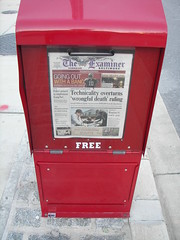Transit and economic development
An indirect example of the link between transit and economic development and the link between population density and economic development comes from Baltimore, and the soon to be closed Baltimore Examiner.
Plans for closure of the paper in a couple weeks has been reported by the Baltimore Business Journal, the Baltimore Sun, and the Washington Examiner. Since the search function for the Washington Examiner is pretty weak, I can't find the article from today's paper in the online edition. Here's the article from the Sun, "The Examiner in Baltimore to close Feb. 15."
The phenomenon of free daily newspaper tabloids in North America has occurred in cities with strong transit systems and population density, because rather than spend money on home delivery systems, the papers are distributed through vending racks and at transit stations, allowing for a fair number of copies to be distributed at a relatively low cost.

Baltimore has a pretty lousy fixed rail transit system. Washington and San Francisco, the home of the other two Examiner newspapers, does not.
Now there were other problems with the expansion to Baltimore. In the current environment, newspapers are reliant on local advertising. There were few synergies from the standpoint of selling advertising between Washington and Baltimore, because the base of potential advertisers is different, and there is little value from cross-over sales--people from DC aren't likely to go buy products from Baltimore businesses advertising in the DC edition and vice versa. The closure of Boscov's Department stores, and the loss of a large advertising account was another, etc.
(Note that the Current Newspapers, with a variety of editions in Northwest DC + Capitol Hill, and the Capital Community Newspapers, with three editions covering most of the city, do cross-sell ads, although my sense is that people in NW aren't likely to patronize businesses in other parts of the city, and vice versa.)
Transit systems + newspapers = good business.
Note that in the 1990s, I wrote something somewhere suggesting that the Washington Times should convert to tabloid format and focus more attention on marketing through the transit system.
Labels: media, transit and economic development, urban economics



0 Comments:
Post a Comment
<< Home